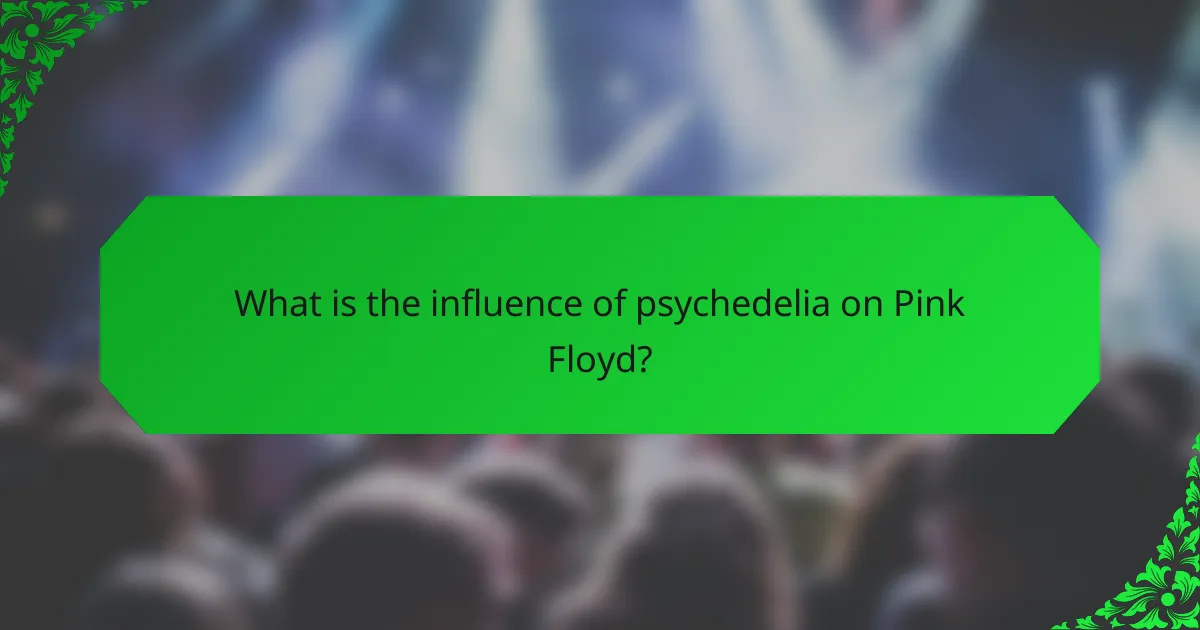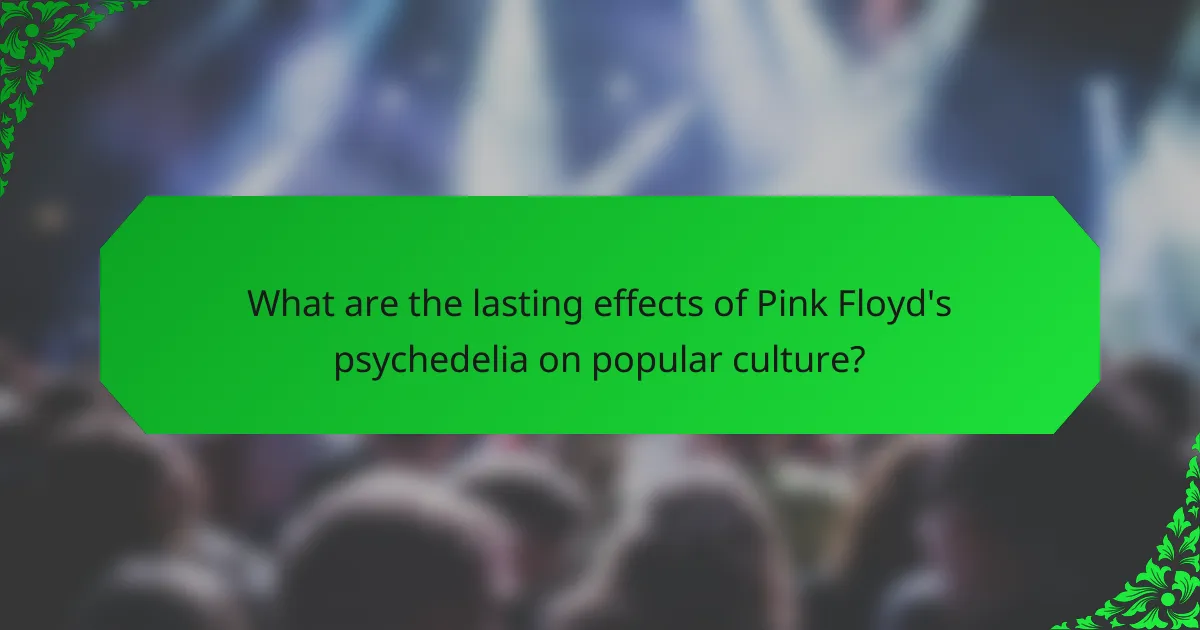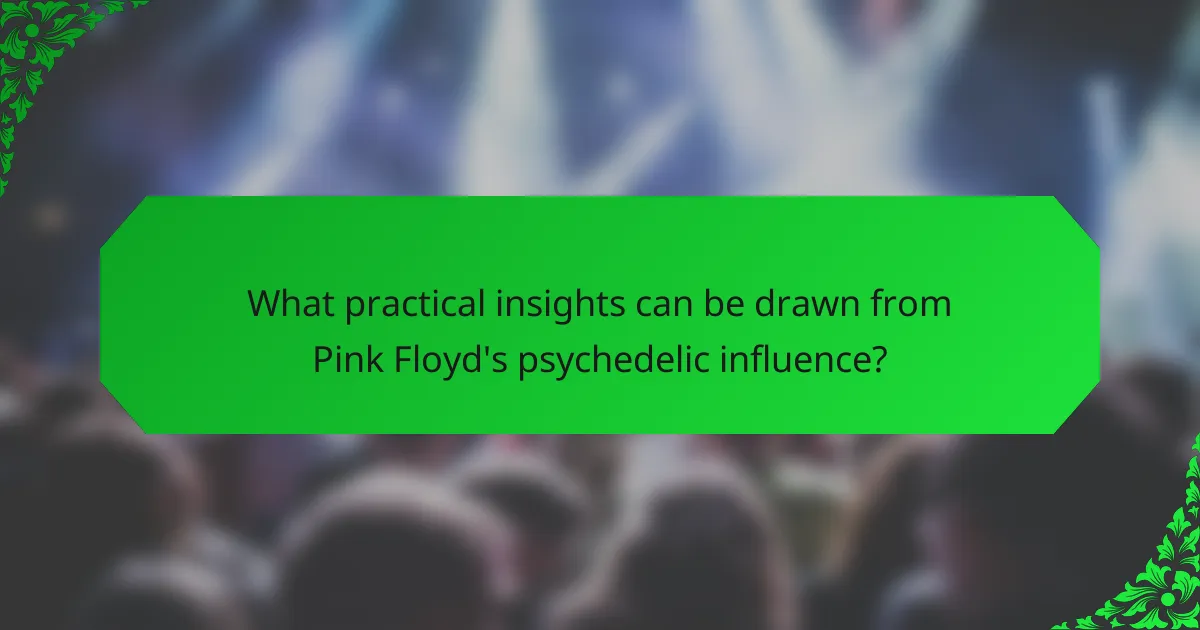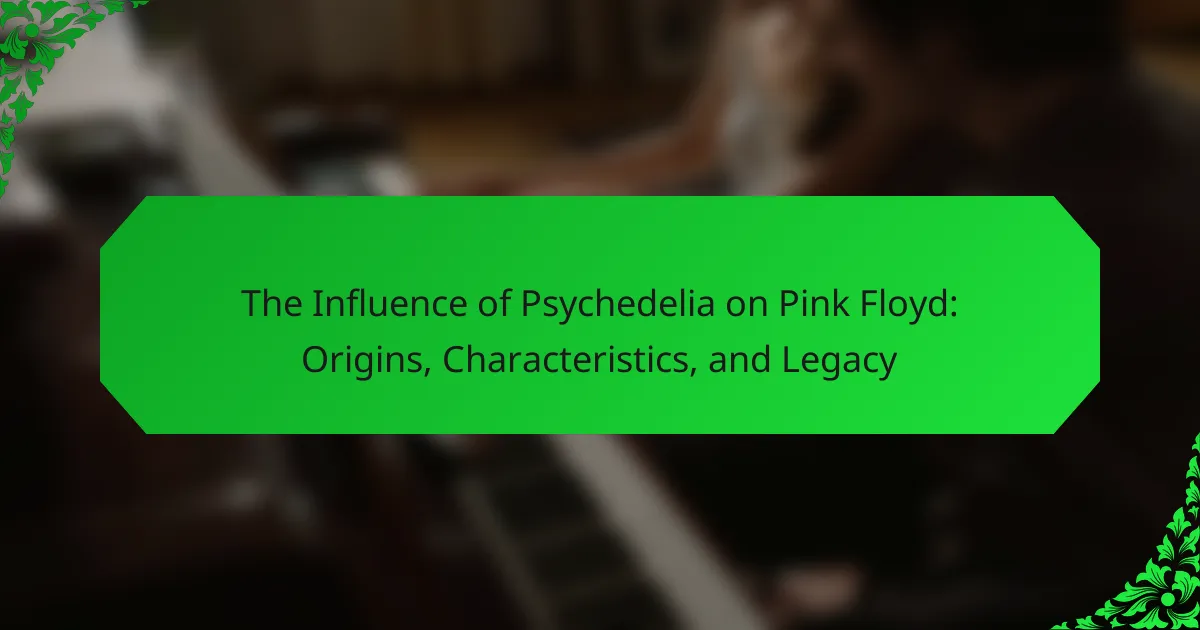Psychedelia is a significant cultural and musical movement that profoundly influenced the British rock band Pink Floyd. The article explores how psychedelia shaped Pink Floyd’s early music, particularly in albums like “The Piper at the Gates of Dawn,” characterized by experimental sound techniques and surreal lyrical themes. It highlights the band’s innovative use of extended instrumental sections and atmospheric soundscapes, along with their integration of visual artistry in live performances and album art. The discussion also covers Pink Floyd’s lasting impact on popular culture, including their role in the development of progressive rock and the broader implications of their themes on contemporary music and art.

What is the influence of psychedelia on Pink Floyd?
Psychedelia significantly influenced Pink Floyd’s music and artistic direction. The band’s early work, particularly on albums like “The Piper at the Gates of Dawn,” was heavily inspired by psychedelic culture. Their sound incorporated experimental techniques, such as tape loops and reverb, which were hallmarks of the genre. The lyrical content often explored themes of consciousness, dreams, and surreal imagery.
The influence of psychedelia is evident in their use of extended instrumental sections and improvisation. Songs like “Interstellar Overdrive” showcased their ability to create atmospheric soundscapes. Additionally, their visual presentations, including light shows and album art, reflected psychedelic aesthetics.
The band’s exploration of mental states and existential themes resonated with the counterculture movement of the 1960s. This connection helped solidify Pink Floyd’s status as pioneers in the psychedelic rock genre. Their work laid the groundwork for future progressive rock artists.
How did psychedelia shape the early sound of Pink Floyd?
Psychedelia significantly shaped the early sound of Pink Floyd through experimental music and innovative techniques. The band incorporated surreal lyrics and extended instrumental sections, which were hallmarks of the psychedelic genre. Their debut album, “The Piper at the Gates of Dawn,” featured unconventional song structures and the use of effects like reverb and echo. These elements created a dreamlike atmosphere, characteristic of the psychedelic experience. The influence of Syd Barrett’s songwriting brought whimsical and abstract themes to their music. Live performances often included light shows and visual effects, enhancing the immersive experience. The band’s exploration of consciousness and perception resonated with the counterculture movement of the 1960s. This fusion of sound and visual artistry solidified Pink Floyd’s place in the psychedelic rock scene.
What musical elements characterize Pink Floyd’s psychedelic phase?
Pink Floyd’s psychedelic phase is characterized by extended instrumental sections, experimental sound effects, and surreal lyrics. The band utilized innovative studio techniques, such as tape loops and reverb, to create immersive soundscapes. Their music often featured unconventional song structures, moving away from traditional verse-chorus formats. The use of synthesizers and electronic instruments was prominent, enhancing their sound’s ethereal quality. Additionally, the incorporation of jazz and blues influences added complexity to their compositions. Notable albums from this phase include “The Piper at the Gates of Dawn” and “A Saucerful of Secrets.” These elements combined to define a unique auditory experience that reflected the psychedelic culture of the 1960s.
How did the band’s lineup changes affect their psychedelic sound?
Lineup changes in Pink Floyd significantly impacted their psychedelic sound. The departure of Syd Barrett led to a shift in musical direction. Barrett’s unique songwriting and guitar style defined their early work. After his exit, David Gilmour joined, bringing a different approach to guitar and vocals. Gilmour’s influence introduced more melodic and structured elements. The addition of new members also diversified their sound palette. This evolution is evident in albums like “The Dark Side of the Moon.” The band’s experimentation with sound and technology expanded during this period. Their lineup changes ultimately shaped their identity within the psychedelic genre.
What are the key characteristics of Pink Floyd’s psychedelic music?
Pink Floyd’s psychedelic music is characterized by experimental soundscapes and surreal lyrics. Their use of extended instrumental sections creates immersive experiences. The incorporation of electronic effects enhances the dreamlike quality of their music. Complex song structures often defy traditional formats. Themes of existentialism and consciousness are prevalent in their lyrics. The band’s innovative use of studio techniques, such as multi-tracking, adds depth to their sound. Visual elements in their live performances complement the music’s psychedelic nature. Albums like “The Piper at the Gates of Dawn” and “The Dark Side of the Moon” exemplify these characteristics.
What lyrical themes are prevalent in Pink Floyd’s psychedelic era?
Lyrical themes prevalent in Pink Floyd’s psychedelic era include existentialism, mental health, and surrealism. Existentialism explores the nature of existence and human experience. This theme is evident in songs like “The Piper at the Gates of Dawn.” Mental health is addressed through lyrics reflecting anxiety and alienation. The song “Brain Damage” highlights the struggles with sanity. Surrealism is marked by dreamlike imagery and abstract concepts. Tracks such as “Interstellar Overdrive” embody this theme with their unconventional structures. Overall, these themes reflect the band’s exploration of consciousness and reality during their psychedelic phase.
How did instrumentation contribute to their psychedelic sound?
Instrumentation played a crucial role in shaping Pink Floyd’s psychedelic sound. The band’s use of unconventional instruments created a unique auditory experience. For instance, the incorporation of the electric guitar produced soaring solos and intricate effects. The use of synthesizers added layers of sound that enhanced the ethereal quality of their music. Additionally, the inclusion of tape loops and sound effects contributed to their experimental approach. The use of the sitar in “Love You To” exemplifies their fusion of Eastern musical elements. These diverse instruments allowed for a rich tapestry of sound that defined their psychedelic era. Overall, instrumentation was fundamental in establishing the distinct sound that characterized Pink Floyd’s music during this period.
Why is the psychedelic phase significant in Pink Floyd’s legacy?
The psychedelic phase is significant in Pink Floyd’s legacy because it established their innovative sound and artistic identity. This period marked the band’s transition from a pop group to pioneers of experimental rock. Their debut album, “The Piper at the Gates of Dawn,” released in 1967, showcased their unique blend of surreal lyrics and innovative soundscapes. The use of extended instrumental sections and studio effects set them apart from contemporaries. Additionally, their incorporation of visual arts in live performances influenced the development of multimedia in rock music. The psychedelic era laid the groundwork for future albums like “The Dark Side of the Moon,” which solidified their status in music history. This phase is often credited with influencing the broader psychedelic movement in music and culture during the late 1960s.
How did this phase influence subsequent music genres?
The phase of psychedelia significantly influenced subsequent music genres by introducing experimental sounds and concepts. Psychedelic rock emphasized improvisation and extended instrumental solos. This laid the groundwork for genres like progressive rock and jam bands. The use of synthesizers and electronic effects became prevalent in later music. Artists such as David Bowie and Tame Impala drew inspiration from psychedelic elements. The lyrical focus on surrealism and altered states of consciousness impacted genres like indie rock and pop. Psychedelia also influenced electronic music through its embrace of technology. This phase marked a shift towards more artistic expression in music.
What impact did psychedelia have on the band’s visual artistry?
Psychedelia significantly influenced Pink Floyd’s visual artistry. The band adopted vibrant colors and surreal imagery in their album covers and stage performances. This shift reflected the psychedelic experience and the counterculture movement of the 1960s. Notable examples include the cover art of “The Piper at the Gates of Dawn,” designed by Peter Blake, which featured abstract visuals. Their live shows incorporated elaborate light displays and projections, enhancing the sensory experience. The use of visual elements aligned with the themes of their music, creating a cohesive artistic expression. This approach set a precedent for future rock concerts, blending music and visual art.
How did Pink Floyd’s psychedelic phase evolve over time?
Pink Floyd’s psychedelic phase evolved significantly from the mid-1960s to the early 1970s. Initially, their debut album, “The Piper at the Gates of Dawn,” showcased experimental sounds and surreal lyrics influenced by the British psychedelia scene. The band’s early music featured whimsical melodies and innovative studio techniques, reflecting the influence of Syd Barrett’s vision. As Barrett’s mental health declined, the band’s sound began to shift.
With the release of “A Saucerful of Secrets,” the band incorporated darker themes and more complex arrangements. By the time they created “The Dark Side of the Moon,” their music had transformed into a more polished and cohesive sound, moving away from pure psychedelia. This album, released in 1973, focused on existential themes and human experiences, marking a departure from their earlier psychedelic roots.
Throughout the 1970s, Pink Floyd’s music continued to evolve, blending elements of progressive rock with their psychedelic origins. Albums like “Wish You Were Here” and “Animals” showcased their ability to merge complex musical structures with profound lyrical content. This evolution solidified Pink Floyd’s legacy as one of the most influential bands in rock history, transcending the psychedelic genre while still acknowledging its roots.
What albums mark the transition from early psychedelia to later styles?
“Sergeant Pepper’s Lonely Hearts Club Band” by The Beatles marks a significant transition from early psychedelia to later styles. Released in 1967, it introduced innovative production techniques and complex song structures. This album influenced many artists and genres that followed. “The Piper at the Gates of Dawn” by Pink Floyd also represents early psychedelia. Released in 1967, it features experimental sounds and surreal lyrics. “The Doors” by The Doors, released in 1967, blends psychedelia with rock and blues elements. It showcased darker themes and a more mature sound. “Odessey and Oracle” by The Zombies, released in 1968, further pushed the boundaries of psychedelia. Its orchestration and melodies marked a shift towards baroque pop. Each of these albums played a crucial role in evolving the psychedelic genre into new musical styles.
How did societal changes during the 1960s and 1970s affect their music?
Societal changes during the 1960s and 1970s significantly influenced music, particularly in the realm of psychedelia. The counterculture movement promoted ideals of peace, love, and rebellion against authority. This created a fertile ground for experimental sounds and lyrical themes in music. Artists began to explore consciousness and [censured], reflecting the era’s fascination with Eastern philosophies and psychedelics. Pink Floyd, for instance, incorporated abstract concepts and surreal imagery in their music. Their album “The Piper at the Gates of Dawn,” released in 1967, exemplifies this trend with its innovative soundscapes. Additionally, the rise of anti-establishment sentiments led to songs that critiqued societal norms and government policies. The music of this period served as both a reflection and a catalyst for social change.

What are the lasting effects of Pink Floyd’s psychedelia on popular culture?
Pink Floyd’s psychedelia has profoundly influenced popular culture. Their innovative sound and visuals shaped the development of progressive rock. The band popularized concepts like concept albums and immersive live performances. Their use of surreal lyrics and experimental sounds inspired countless artists across genres. The iconic album “The Dark Side of the Moon” has sold over 45 million copies worldwide. This album’s themes of mental illness and existentialism resonate in contemporary music and art. Pink Floyd’s visual artistry set a standard for music videos and stage design. Their influence extends to film, fashion, and even literature, reflecting a broader cultural impact.
How has Pink Floyd influenced modern artists and musicians?
Pink Floyd has significantly influenced modern artists and musicians through their innovative sound and conceptual albums. Their use of experimental techniques, such as extended instrumental sections and sound effects, has inspired countless musicians. Albums like “The Dark Side of the Moon” and “The Wall” introduced thematic storytelling in music, influencing narrative-driven works in various genres.
Many contemporary artists cite Pink Floyd as a major influence on their creative processes. For instance, bands like Radiohead and Muse have adopted similar atmospheric soundscapes and introspective lyrics. Additionally, Pink Floyd’s pioneering use of visual elements in live performances has set a standard for modern concert experiences. Their blend of rock with elements of jazz and classical music has encouraged genre fusion in today’s music scene.
The band’s exploration of complex themes, including mental health and societal issues, resonates with current artists addressing similar topics. Overall, Pink Floyd’s legacy continues to shape the musical landscape, inspiring innovation and creativity across generations.
What specific elements of their psychedelic style are still present in contemporary music?
Contemporary music retains several elements of psychedelic style, including experimental soundscapes. These soundscapes often utilize reverb and delay effects, creating an ethereal atmosphere. Additionally, the use of unconventional song structures is prevalent. Many contemporary artists incorporate long instrumental sections and extended solos.
Moreover, lyrical themes often explore surrealism and introspection. This reflects the psychedelic focus on consciousness and perception. Visual aesthetics in music videos also draw from psychedelic art, featuring vibrant colors and abstract imagery.
Finally, the resurgence of analog instruments, such as synthesizers and vintage guitars, echoes the classic psychedelic sound. Artists like Tame Impala and MGMT exemplify these elements in their music.
How do modern visual artists draw inspiration from Pink Floyd’s psychedelic visuals?
Modern visual artists draw inspiration from Pink Floyd’s psychedelic visuals by utilizing vibrant colors and abstract forms. These artists often replicate the surreal imagery associated with Pink Floyd’s album art and live performances. The use of light projections and multimedia installations reflects the band’s innovative approach. Artists like David Carson and Storm Thorgerson have influenced contemporary works with their graphic designs. Additionally, the themes of consciousness and perception in Pink Floyd’s music resonate in modern art. This connection highlights the lasting impact of Pink Floyd’s aesthetic on visual culture. Their legacy encourages experimentation and exploration in artistic expression.
What role did live performances play in Pink Floyd’s psychedelic legacy?
Live performances were crucial in establishing Pink Floyd’s psychedelic legacy. They provided a platform for the band’s experimental sound and visual artistry. The use of elaborate light shows and projections enhanced the immersive experience. Concerts like the 1967 show at the UFO Club showcased their innovative approach. This performance featured extended improvisations, emphasizing spontaneity and exploration. The band’s iconic album “The Dark Side of the Moon” was brought to life through live renditions. These performances often included unique arrangements that differed from studio recordings. The combination of music and visual elements created a profound impact on audiences. This synergy solidified Pink Floyd’s reputation as pioneers of psychedelic rock.
How did their concert experiences shape audience perceptions of psychedelia?
Concert experiences significantly shaped audience perceptions of psychedelia. Pink Floyd’s live performances often featured elaborate light shows and immersive soundscapes. These elements created a sensory experience that resonated with the psychedelic culture of the 1960s and 1970s. Audiences associated the band’s music with altered states of consciousness. The integration of visual art and music deepened this connection. Concerts became a communal space for exploration of new ideas and experiences. This atmosphere encouraged fans to embrace the psychedelic movement. Historical data shows that their concerts attracted diverse crowds seeking transformative experiences. Overall, Pink Floyd’s concerts helped define and popularize the perception of psychedelia in popular culture.
What innovations in live shows emerged from Pink Floyd’s psychedelic era?
Pink Floyd’s psychedelic era introduced several key innovations in live shows. They were pioneers in integrating elaborate visual effects with music. This included the use of slide projections and light shows that enhanced the auditory experience. Their concerts featured large-scale visual displays, such as inflatable props and intricate stage designs. The band also utilized quadraphonic sound systems for immersive audio experiences. These innovations set a precedent for future live performances in rock music. Their iconic “The Wall” tour further exemplified theatrical storytelling in concerts. These advancements influenced many artists and shaped the evolution of live music events.

What practical insights can be drawn from Pink Floyd’s psychedelic influence?
Pink Floyd’s psychedelic influence emphasizes the importance of creativity and experimentation in music. Their use of innovative soundscapes and studio techniques reshaped musical boundaries. The band integrated visual art with music, enhancing the overall experience for listeners. This approach demonstrates the value of interdisciplinary collaboration in artistic expression. Their exploration of themes like consciousness and perception resonates with audiences, encouraging self-reflection. The band’s success illustrates the potential of pushing artistic limits to achieve lasting impact. Pink Floyd’s legacy continues to inspire musicians to embrace unconventional methods and ideas.
How can aspiring musicians incorporate elements of psychedelia into their work?
Aspiring musicians can incorporate elements of psychedelia into their work by using experimental sounds and unconventional song structures. They should explore the use of reverb, delay, and modulation effects to create immersive soundscapes. Incorporating non-traditional instruments, such as synthesizers and sitars, can enhance the psychedelic feel. Additionally, musicians can draw inspiration from surreal lyrics and abstract themes. Visual elements, like vibrant album art and light shows, can also play a significant role. Historical examples include bands like Pink Floyd, who utilized these techniques to create their signature sound. Their album “The Piper at the Gates of Dawn” is a prime example of early psychedelic music.
What techniques can be used to create a psychedelic sound in music production?
Techniques to create a psychedelic sound in music production include the use of reverb, delay, and modulation effects. Reverb adds depth and space, creating an ethereal quality. Delay can produce echo effects that enhance rhythmic complexity. Modulation effects like chorus and flanger add movement and richness to sounds. Additionally, unconventional song structures and time signatures contribute to a psychedelic feel. Experimentation with instruments and sound sources, such as synthesizers and found sounds, also plays a crucial role. Layering sounds and using panning techniques can create a dynamic soundscape. These techniques are rooted in the experimental approaches used by bands like Pink Floyd.
What resources are available for learning about psychedelic music history?
Books, documentaries, and online courses are available for learning about psychedelic music history. Notable books include “Psychedelic Music in the 1960s” by Andrew McKaige and “Electric Eden” by Rob Young. Documentaries like “The Psychedelic Revolution” provide visual context. Websites such as AllMusic and Pitchfork offer articles and reviews on psychedelic music. Online platforms like Coursera and MasterClass feature courses on music history that include sections on psychedelia. These resources collectively cover the evolution, key figures, and cultural impact of psychedelic music.
The main entity of the article is Pink Floyd, a band significantly influenced by psychedelia in their music and artistic direction. The article explores the origins of this influence, detailing how their early work incorporated experimental techniques, surreal lyrics, and extended instrumental sections characteristic of the psychedelic genre. It examines key characteristics of their psychedelic phase, including instrumentation, lyrical themes, and the impact of lineup changes on their sound. Additionally, the article discusses the lasting legacy of Pink Floyd’s psychedelia on popular culture and its influence on modern artists and genres.
